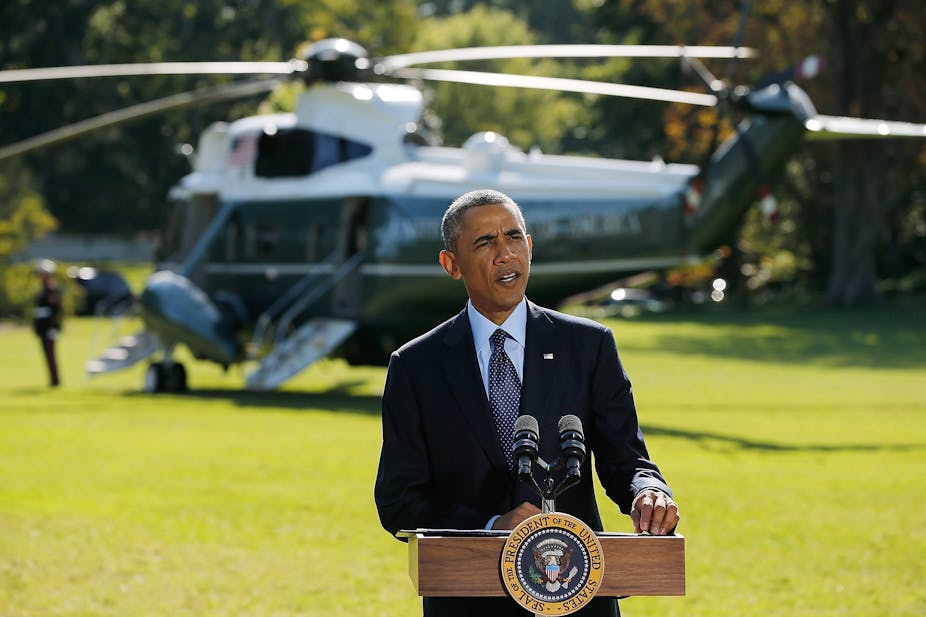Having secured some sort of tacit agreement with Damascus, the coalition bombing campaign inside Syria proper has begun in earnest. The US, France and an ambiguous array of allies is unleashing the bleeding edge of modern air power in Levantine airspace.
The case for war has been justified by the threat of Islamic State (IS, also known as ISIL or ISIS). However, coalition efforts have also targeted other militant Islamist groups, including the Al Nusrah front and the enigmatic Khorasan group.
Although both al Qaeda-linked organisations, attacking these groups under the umbrella of the broader campaign demonstrates a clear deviation from the original stated goals of the intervention, to “degrade and defeat” IS.
This early-stage “mission creep” harkens to a deeper concern held by many in academic and policy circles: what comes next?
Bomb up, stupid
Although seductive in its simplicity, a strategy formulated around a calculus of ordnance per square inch will not deal with the root cause of the IS threat. Airstrikes can certainly kill large numbers of militants. They cannot resolve the social, political and ideological issues that have drawn a steady stream of these local and international recruits to fight under the group’s banners over the past two years.
While airpower alone has arguably proven effective against nation states like Japan and Serbia in the past, its ability to elicit strategic gains when employed against non-state actors has yet to be demonstrated. Whereas states have infrastructure to be targeted, insurgent organisations thrive in environments in which such capacity has been already been devastated.
Further, the use of overwhelming military force against non-state actors has often served to draw additional support to their cause. The rising popularity of Hamas in the wake of the recent Gaza conflict is one such example of this pattern, as was the similar boost experienced by Hezbollah after its 2006 war with Israel.

This is not to say bombing is never effective or warranted. The use of force to avert a region-wide disaster as IS began its blitzkrieg across Iraq last month was clearly necessary for a range of strategic reasons.
But stymieing the advance of the al Qaeda disaffiliate was a tactical victory, not a strategic one. As Henry Kissinger famously said in Foreign Affairs:
The conventional army loses if it does not win. The guerrilla wins if he does not lose.
For groups like IS, endurance in the face of seemingly overwhelming odds can be victory in and of itself, affirmed through theatrical shows of force like the decapitation of Western journalists, which demonstrate their capacity to dictate and shape narrative.
The portrayal of IS as the underdog resisting a powerful, imperialist West and confronting a deviant Shia regime is a compelling image. It clearly appeals to many young Sunni Muslim men and women looking to affirm their identity across the world. For many, the notion of Islamic State offers not only a chance to participate directly in a dynamic and romantic cause, but also an avenue through which to reinvent reality as a Utopian ideal - the caliphate.
Although Obama’s characterisation of Islamic State’s ideology as “empty” may make for a good soundbite, for IS followers, its espoused ideals are anything but.
Bad governance, bad responses
The ability for such radical ideas to coalesce through wider militant movements in modern times is almost always reliant on the breakdown of state structure and governance. Islamic State’s previous incarnation, Al Qaeda Iraq (AQI), festered in the lawless regions of western Iraq before a popular uprising of locals and their temporary co-option by US-led coalition forces and the Iraqi state finally caused the group to collapse.
The ability of elements of AQI to reconstitute themselves parochially as both ISIS and Al Nusra has been intimately linked to the breakdowns of governance that have occurred in the Syrian civil war since 2011 and in western Iraq under the past five years of the Maliki regime.
The successes afforded to such groups by the relative vacuum they operate in have in turn proven a powerful draw for many disaffected Muslims across the globe. They see groups like IS as a panacea for challenging the forces they perceive to have wronged them and their community.
Solving the structural factors that lead to IS, then, requires not only re-establishing effective state capacity in Iraq and Syria, but also overcoming deep schisms developing in the West between Muslim and majority populations.
For the former, much more is needed than the training of a mere 5,000 members of the free Syria army in Saudi Arabia or Georgia. Ultimately, what may be required is some sort of uncomfortable compromise with the Assad regime.
Answers to the latter challenge are even less clear, given the general direction many Western states appear to be heading with regards to their domestic Muslim diasporas.
Given the generally dismal experience of the Arab Spring and the current hyper-partisan politics in much of the West, it is easy to understand why many leaders may resort to the instinctively aggressive “Id” option of simply blowing things up.

